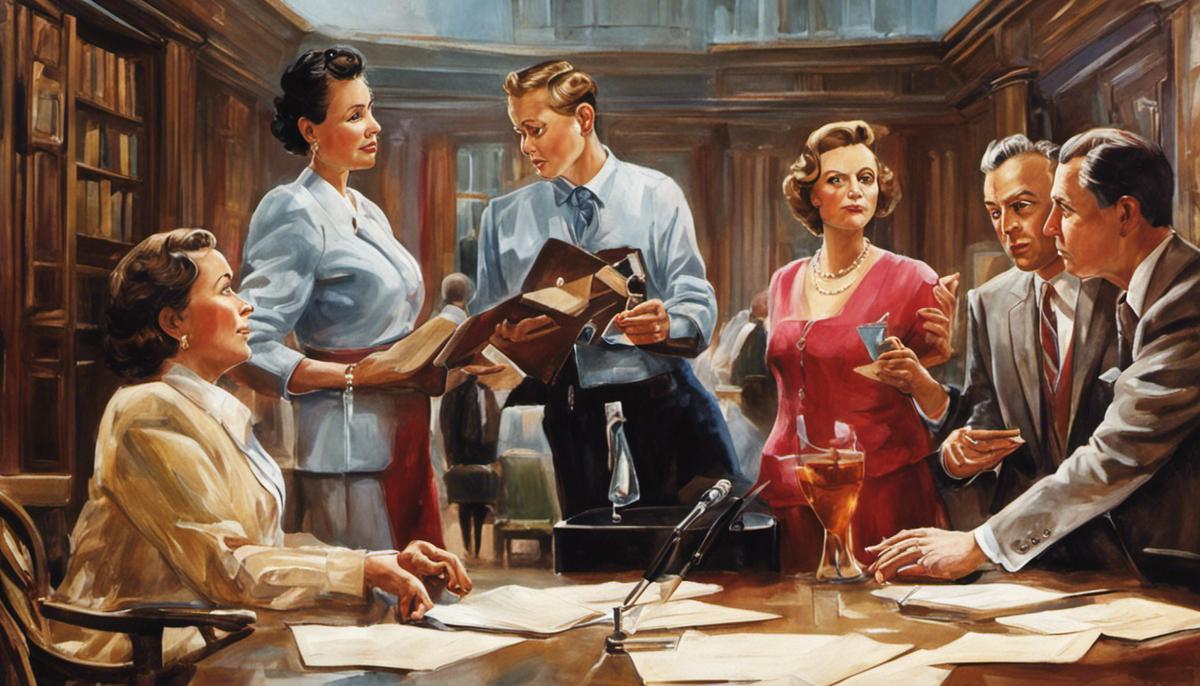Leadership and decision making are two inseparable elements in managing and steering any organization towards success. Effective leadership requires the ability to make sound decisions, thereby influencing an organization’s success and the well-being of its employees. As such, understanding leadership decision making, its intricacies, implications, styles, and strategies is fundamentally important. With an overarching focus on this, our analysis also delves into emotional intelligence’s significance in decision-making, leadership in times of crisis, and strategies to enhance leadership decision-making skills. Throughout, real-life examples are used for a better understanding and practical application.
Understanding Leadership Decision Making
The Importance and Role of Decision-Making in Leadership
Understanding the weight of decision-making in leadership is pivotal to ensuring the efficient operation of an organization. Each choice a leader makes influences the trajectory of their team and the company as a whole. Leaders dictate team morale, enact policies, and set objectives, each of which can alter the productivity and viability of a business.
How Leadership Decision Making Affects an Organization
Leadership decision-making takes a central role in the organization’s life, shaping every function, procedure, and outcome. Decisions about strategy, making up a project team, distributing resources, establishing company culture, or setting a customer service policy have reverberating effects across the organization. Making accurate and beneficial decisions enhances productivity, fosters employee satisfaction, cultivates confidence with customers, and positively impacts the bottom line.
Conversely, poor decision-making can lead to decreased productivity, diminishing employee morale, customer dissatisfaction, and a weakened financial position. Mistakes are inevitable, but when there is a pattern of poor decision-making, stakeholders, whether they are employees, customers, or investors, begin to lose trust in the leader and, by extension, the organization.
Impact on Employees
A leader’s choices directly impact the comfort and satisfaction of employees. When employees perceive that their leaders are making fair and rational decisions, they’re more likely to feel respected and motivated in their roles. The opposite is also true. If employees sense their leaders are making impulsive decisions or ones that favor certain personalities over others, it can result in erosion of trust, poor morale, increased turnover, and reduced productivity. Effectively, the leader’s decision-making style can either motivate or demotivate employees, making it crucial for leaders to understand the ramifications of their choices.
Different Styles of Leadership Decision-Making
There are different styles of leadership decision-making, primarily characterized by authoritarian, democratic, and laissez-faire methods. Authoritarian leaders centralize decision-making, exercising a high level of control. While this style can expedite decisions, it might lead to resentment or disengagement if subordinates feel their input is not valued.
Democratic leaders, on the other hand, involve group members in the decision-making process, fostering a sense of ownership and cooperation. However, decision-making can be time-consuming as it requires consensus.
Laissez-faire leaders give their team the freedom to make decisions with minimal interference. While this method can empower employees, it may engender chaos if the team lacks competence or is unclear on objectives.
An effective leader does not stick rigidly to one style but adjusts according to the situation and team dynamics.
Examining Leadership Styles and Their Impact on Decision-Making
Every leadership style brings its unique set of pros and cons, especially in the context of decision making. For instance, an authoritative decision-making style offers the advantage of quick decisions, essential in emergencies. However, its downside includes the potential to ostracize team members or limit innovation due to the absence of a diversity of ideas.
In contrast, a democratic decision-making method encourages creativity and enhances team morale, as team members’ opinions are respected and valued. But, it may inadvertently delay the decision-making process and may lead to disagreements if a group consensus is challenging to achieve.
Then there’s the laissez-faire style of leadership, which advocates for employee autonomy and can foster both personal and professional growth. However, if the leader disengages excessively or if the team lacks the essential abilities to guide themselves, it can cause disarray.
Thus, comprehending each style’s potential impacts enables leaders to adapt their decision-making approach to different situations, enhancing their effectiveness.

Strategies and Models in Leadership Decision Making
Delving Into the Rational Decision-Making Model
Leaders often rely on the Rational Decision-Making Model, a method grounded in logic and meticulous analysis. Leaders using this model start by identifying a problem, brainstorming potential solutions, assessing these options, picking the optimum one, applying it, and lastly, evaluating the outcome. The strength of this model is its organized framework that considers all elements of an issue thoroughly. Nevertheless, it assumes the availability of complete information and that decisions are always logically driven – not a constant reality. For example, when Steve Jobs introduced the iPhone, Apple employed this model. They recognized a gap in the market, explored possible solutions, evaluated different design options, chose the best one, and then conducted tests and evaluations of the product in the market.
The Intuitive Decision-Making Model
Contrasting the rational model is the Intuitive Decision-Making Model. This approach depends on the leader’s instincts, experience, and gut feelings rather than detailed analysis. It’s typically used in high-pressure situations where quick decisions are needed. However, the downside of this model is that it can lead to ill-informed decisions if the leader’s instincts are off. For example, when Warren Buffett decided to invest in Goldman Sachs during the 2008 financial crisis, he relied heavily on his intuitive understanding of the market and the company’s potential.
The Vroom-Yetton-Jago Decision Model
The Vroom-Yetton-Jago Decision Model is a framework that helps leaders decide how much participation to allow from their team during the decision-making process. Here, leaders consider the significance of the decision, the need for team commitment, and the competency of the team in making the decision. Leaders using this model need to be flexible in adjusting their leadership style depending on the situation. However, it might be challenging to identify accurately the level of involvement needed from the team at times. For example, Marissa Mayer, during her stint as the CEO of Yahoo, had to make decisions regarding Yahoo’s strategic direction where she used this model to involve her senior management team in the process.
Carnegie Mellon University’s Incremental Model
An additional model of decision-making is Carnegie Mellon University’s Incremental Model. Also known as the ‘muddling through’ approach, it suggests that leaders make decisions step-by-step, refining their approach as they gather further information. This process allows for flexibility and adjustments along the way. However, it can lead to inefficiency if not properly managed. An example of the Incremental Model in use might be Google’s approach to developing its self-driving cars. They didn’t start with a fully formed product but have incrementally improved their technology with each test drive.
Strategies for Effective Group Decision Making
In operational scenery where decisions must involve a team or a whole department, various efficacious strategies for group decision-making exist. Tactics such as brainstorming, employing the Delphi method, or utilizing the nominal group technique permit team members to either contribute their ideas individually or as a unified entity. This allows for a diversity of skills, insights and knowledge within the team to be harnessed, creating a comprehensive approach. Nevertheless, this method may be time-consuming and has the potential to give rise to disputes. A practical example of this is Amazon’s ‘disagree and commit’ policy, a strategy for group decision-making which appreciates diverse viewpoints but also promotes forward momentum and pledge.

Role of Emotional Intelligence in Decision Making
Role of Emotional Intelligence in Leadership Decision Making
Emotional intelligence is the capability to acknowledge, utilize, and handle emotions constructively. This ability can help mitigate stress, improve communication, foster empathy, surmount obstacles and resolve disagreements. Within leadership decision making, emotional intelligence serves a key purpose. It not only affects a leader’s capacity to make knowledgeable choices but also infuses empathy into those decisions, thereby balancing the objective with the subjective.
The Role of Emotional Intelligence in Leadership Decision Making
Emotional intelligence in leadership decision-making is paramount. Leaders with high levels of emotional intelligence can accurately perceive and understand their emotions and how they impact others. This awareness can help in making strategic decisions that take into account not only the immediate and tangible factors but also the emotional and human elements. For instance, a leader with high emotional intelligence would consider the emotional impact of a layoff decision on the employees and the organization’s morale, thus exploring alternatives before reaching such a drastic conclusion.
On the other hand, leaders with low emotional intelligence may make hasty decisions based solely on facts and figures, neglecting the human aspect and the emotional ramifications. These decisions may lead to unforeseen negative outcomes like decreased employee morale or lack of trust in leadership.
Emotional Intelligence Influencing Decision Making Process
Emotional intelligence can vastly alter the decision-making process. Emotionally intelligent leaders tend to make more thoughtful decisions by recognizing their emotions and understanding how these feelings can influence their choices. These leaders realize the importance of making decisions in a calm and composed state rather than acting on high emotions that can lead to rash and potentially harmful choices.
In addition, emotionally intelligent leaders understand the emotions of their team members. They take these emotions into account when making decisions, further contributing to the transparency and inclusivity of their leadership style. This emotional understanding results in more empathetic decisions, improving team cohesion and the overall morale of the organization.
Improving Emotional Intelligence in Leaders
Leaders can improve their emotional intelligence through self-assessment, feedback, and training. Self-awareness is the first step to improving emotional intelligence. Leaders should reflect on their emotions, reactions, and decision-making patterns to understand what triggers strong emotions and how best to manage them.
Gathering feedback from colleagues, peers, and subordinate staff also provides valuable insight into a leader’s emotional intelligence. How a leader reacts to criticism or responds to emotional situations can provide a roadmap for improvement.
Training, whether formal or informal, is another useful tool for enhancing emotional intelligence. Workshops, role-play exercises, and professional development courses can equip leaders with practical strategies to manage their emotions, increasing their effectiveness in making sound decisions.
Conclusively, the significance of emotional intelligence in leadership decision making can not be overstated. Leaders who exhibit high levels of emotional intelligence are able to make decisions that are not just effective, but also empathetic – a characteristic that greatly enhances their contributions to their team and the entire organization. As such, leaders aiming to refine their decision-making capabilities should consider enhancing their emotional intelligence as a strategic development priority.

Leading Through Crisis: Decision Making in Difficult Times
Delving into Crisis Leadership and Decision Making
Beyond general decision making, leaders are also faced with the often daunting task of crisis leadership and decision making – essential skills in an increasingly volatile, uncertain, complex, and ambiguous global environment. A leader’s mettle is truly tested during crisis periods, as their capacity to make crucial decisions under tension, uncertainty and intense pressure comes under the spotlight. Furthermore, crisis situations, which tend to emerge unexpectedly and demand swift, decisive actions under high-stake circumstances, present unique challenges.
Key Elements for Decision-Making in Crises
Several key elements are necessary for making crucial decisions in the midst of a crisis. First, leaders must establish a sense of calm. The ability to remain calm under pressure allows a leader to think clearly and logically; panic only adds to the chaos and impedes effective decision making.
Secondly, gathering accurate and timely information is vital. Leaders need to understand the situation as fully as possible; having incomplete or incorrect information can lead to misunderstandings and poor decisions. They also need to be aware that information in a crisis situation can change rapidly and stay flexible and adaptive.
Thirdly, leaders should draw upon their core values during situations of crisis. These will provide a stable foundation to guide their decision-making processes.
Finally, leaders should maintain an honest and transparent communication with everyone involved. Transparency helps build trust and cooperation, which can be invaluable during a crisis situation.
Common Decision-Making Pitfalls
Despite the best efforts, leaders can fall into common pitfalls during crisis management. Paralysis by analysis is a common problem where leaders get so caught up in gathering and analyzing information that they delay or fail to make crucial decisions. Another common pitfall is the failure to communicate effectively. In the heats of a crisis, messages can be miscommunicated or misunderstood. It’s important for leaders to ensure that their decisions and the rationale behind them are clearly communicated to every stakeholder.
Fostering Excellence in Leadership Decision-Making
Enhancing decision-making abilities is a perpetual endeavor for leaders. They have the capacity to draw from a rich well of past experiences, consisting of both victories and defeats. In the wake of every crisis, it is incumbent upon leaders to introspect by evaluating their decisions, understanding the repercussions and devising strategies for enhancement. This process of reflection, known as an after-action review, is an indispensable element of continuous leadership growth.
Furthermore, soliciting feedback from subordinates and correlating stakeholders in the crisis process can shed light on areas that may have been overlooked and those requiring enhancement. Last but not least, continuous learning opportunities such as scenario-based training, case study evaluations or professional development modules can provide productive ways to refine leaders’ decision-making prowess, equipping them more effectively for forthcoming crises.

Training and Improving Leadership Decision-Making Skills
Commanding mastery over decision-making is paramount for any leader. It is an intricate skill encompassing the selection of a favorable path from a bevy of possible efforts aimed at attaining a set objective. Compelling decision-making skills are the product of a delicate blend of intuition, robust analytical ability, and the facility to predict possible outcomes. Leaders should excel at comprehending and weighing the potential risks tied to every decision, and exhibit courage in taking calculated risks when circumstances demand it. Given that their decisions are bound to create ripples across their teams and organizations, the gravity of effective decision-making is heavily amplified in leadership roles.
There are numerous training programs available to improve leadership decision-making skills. Such programs focus on developing critical thinking, emotional intelligence, strategic thinking, and problem-solving abilities among leaders. For example, The Kepner-Tregoe Foundation for Critical Thinking offers leadership programs geared towards effective decision-making. The program includes defining, analyzing, proposing and taking action on decisions, and reviewing the decision after implementation. Another is the Center for Creative Leadership (CCL) which offers leadership decision-making courses that focus on preparing leaders to make competent decisions in crisis situations.
Online learning platforms such as Coursera and LinkedIn Learning also provide a plethora of courses focusing specifically on decision-making in leadership, equipping leaders with practical techniques and frameworks to facilitate sound decision-making.
Apart from formal training programs, there are myriad resources available for leaders aiming to bolster their decision-making abilities. Leadership books such as “Thinking, Fast and Slow” by Daniel Kahneman and “Decisive: How to Make Better Choices In Life And Work” by Chip and Dan Heath provide beneficial insights into the cognitive process behind decision-making and offer actionable tips for leaders.
Podcasts like “The HBR IdeaCast” and “The Daily Coach” also provide valuable lessons on leadership and decision-making. These audio resources are especially useful for busy leaders, as they can be consumed on-the-go and usually focus on practical strategies that can be readily implemented.
Industry leaders and experts often share their wisdom and experiences in decision-making. A common advice is to not rush the decision-making process – taking adequate time ensures that all aspects of the decision are thoroughly considered. Jeff Bezos, Founder and CEO of Amazon, shares his “disagree and commit” principle where team members are encouraged to openly disagree in decision discussions, but once a decision is finalized, everyone commits fully to its implementation.
Another advice from experts is promoting transparency in decision-making. Leaders who involve their team in the decision-making process foster trust and commitment while benefiting from diverse perspectives. Finally, acknowledging that no decision will be perfect and learning from failures is crucial, mastering the art of decision-making involves taking calculated risks, evaluating outcomes and learning from mistakes.
A practical and recommended step to enhance decision-making is through consistent practice. Leaders can role-play or simulate decisions, followed by reflection and feedback to identify areas of improvement. Another step is continually learning and staying informed about their industry and related fields since a more comprehensive understanding of the field can aid in decision-making.
Leaders can also enhance their decision-making by seeking mentorship or coaching from experienced individuals, helping them gain insights into effective strategies and avoiding common pitfalls. Additionally, investing time in self-reflection and mindfulness can significantly improve decision-making abilities, as these practices promote calmness and clarity, both of which are indispensable in the decision-making process.

The true measure of leaders often lies in the decisions they make and the strategic approaches they adopt to deal with uncertainties. This necessitates the need for well-informed, empathetic and strategic decision making, among others. Building these skills takes time, practice, and reflection. As we have explored throughout this exploration, strategies and models do exist that enable leaders to navigate through decisions, crises and the management of their emotions effectively. Equipped with these tools and insights, today’s professionals can pave their way towards more effective leadership decision-making, thereby influencing positive organizational change and development.